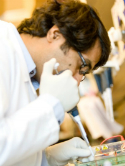| Abstract: |
Background: Apple juice is considered to be an important component of the healthy diet, with anticancer activities in colon cancer animal models and key ingredients have numerous chemoprotective activities in human colon cells in vitro. Aim of the study: Since only little is known on comparable activities in the human colon in vivo, here a pilot study was performed to assess related mechanisms caused by ileostomy samples from volunteers that had consumed apple juice. Methods: Ileostomy samples were collected after intervention (0-8 h) with cloudy apple juice (1 l). They were characterized analytically for major apple polyphenols and biologically in HT29 colon cells for their potential to cause genotoxic damage, protect from the genotoxic insult by hydrogen peroxide (H 2O2) and modulate the expression of GSTT2, an enzyme related to antioxidative defence against different peroxides. Results: The analytical determination of polyphenols in the ileostomy samples revealed that the majority of the compounds were recovered in the samples collected 2 h after intervention. The comparison of genotoxic effects of samples before intervention and 2 h after intervention revealed a considerable variation of genotoxic response, but there was a trend for reduced genotoxicity in three of eight persons (P) after intervention. Samples collected at 2 h protected HT29 cells from genotoxic damage by H2O2 (for 4 of 8 persons), resulted in an increased GSTT2 expression (for 2 of 6 persons) and of GSTT2 promotor activity (2 of 6 persons). Conclusions: The intervention with apple juice results in bioavailable concentrations of related polyphenols in the gut lumen, which could contribute to reduced genotoxicity, enhanced antigenotoxicity and favorable modulation of GSTT2 gene expression in some individuals. The pilot study for the first time used this combination of faecal biomarkers which in larger cohorts may either reveal overall significant alterations of chemoprotection or may be used to identify individuals which could particularly benefit from a personalized nutrition. © 2008 Spinger. |



